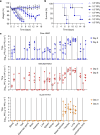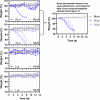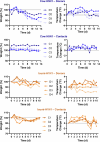Pathogenicity and transmissibility of bovine H5N1 influenza virus
- PMID: 38977017
- PMCID: PMC11390473
- DOI: 10.1038/s41586-024-07766-6
Pathogenicity and transmissibility of bovine H5N1 influenza virus
Abstract
Highly pathogenic H5N1 avian influenza (HPAI H5N1) viruses occasionally infect, but typically do not transmit, in mammals. In the spring of 2024, an unprecedented outbreak of HPAI H5N1 in bovine herds occurred in the USA, with virus spread within and between herds, infections in poultry and cats, and spillover into humans, collectively indicating an increased public health risk1-4. Here we characterize an HPAI H5N1 virus isolated from infected cow milk in mice and ferrets. Like other HPAI H5N1 viruses, the bovine H5N1 virus spread systemically, including to the mammary glands of both species, however, this tropism was also observed for an older HPAI H5N1 virus isolate. Bovine HPAI H5N1 virus bound to sialic acids expressed in human upper airways and inefficiently transmitted to exposed ferrets (one of four exposed ferrets seroconverted without virus detection). Bovine HPAI H5N1 virus thus possesses features that may facilitate infection and transmission in mammals.
© 2024. The Author(s).
Conflict of interest statement
The authors declare no competing interests.
Figures














Comment in
-
Bovine H5N1 binds poorly to human-type sialic acid receptors.Nature. 2025 Apr;640(8059):E18-E20. doi: 10.1038/s41586-025-08821-6. Epub 2025 Apr 16. Nature. 2025. PMID: 40240859 No abstract available.
-
Receptor-binding specificity of a bovine influenza A virus.Nature. 2025 Apr;640(8059):E21-E27. doi: 10.1038/s41586-025-08822-5. Epub 2025 Apr 16. Nature. 2025. PMID: 40240861 No abstract available.
References
-
- USDA Animal and Plant Health Inspection Service. Highly Pathogenic Avian Influenza (HPAI) Detections in Livestock. USDAwww.aphis.usda.gov/livestock-poultry-disease/avian/avian-influenza/hpai-... (2024).
-
- CDC Confirms Second Human H5 Bird Flu Case in Michigan; Third Case Tied to Dairy Outbreak. CDCwww.cdc.gov/media/releases/2024/p0530-h5-human-case-michigan.html (2024).
-
- Uyeki, T. M. et al. Highly pathogenic avian influenza A(H5N1) virus infection in a dairy farm worker. N. Engl. J. Med.10.1056/NEJMc2405371 (2024). - PubMed
-
- Guan, L. et al. Cow’s milk containing avian influenza A(H5N1) Virus - heat inactivation and infectivity in mice. N. Engl. J. Med.10.1056/NEJMc2405495 (2024). - PubMed
MeSH terms
Substances
Grants and funding
LinkOut - more resources
Full Text Sources
Medical
Miscellaneous

